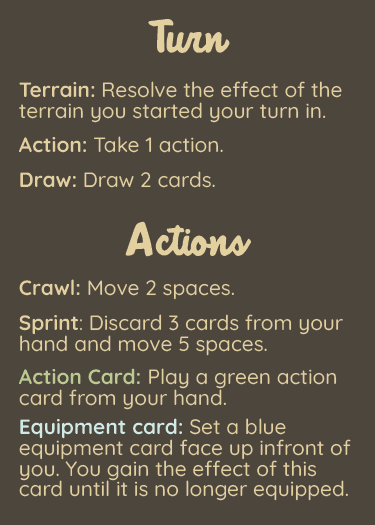Outrun the Bear testing and development continues without letup. This month’s newsletter will focus on the changes that have been made as a result of that testing. Hope you enjoy!
Why am I changing the game?
If you’ve had the chance to play Outrun the Bear at a convention or a met me at a store location in the past you know that it’s playable. I hope you also enjoyed your time playing the game, I know I have enjoyed playing with everyone who has sat down at my table.
Still, my biggest fear is making a game that is simply “Meh.” I want Outrun the Bear to be a game that you routinely take off your game shelf and make great memories with for you, your friends, and your family for years to come. My previous version was just not there yet.
What needed changing?
After recent play tests a few issues just couldn’t be ignored any longer:
- Turns took so long that the game didn’t feel exciting.
- Sprint actions were always the best choice.
- Reaction cards were too difficult to play.
- A lack of jockeying for position made the game not feel like a race.
- The Bear’s pacing was too sporadic.
What changes did I make?
First, I simplified the turns.
In the past iteration of the game a turn would start with an effect based on the terrain you occupied; following that were three actions that could be used to play cards, draw cards, or discard three cards to move 6 spaces, and then ended with another terrain effect.
This meant that as a player you would have to make a minimum of three decisions per turn, which might be enjoyable for a game that has a serious puzzle nature– but just slows down an action themed game like this one.
Now, each turn consists of 3 simple steps:
- Resolve the terrain you start your turn in
- Play an action, which could be playing a card, crawling (moving 2 spaces), sprinting discarding 3 cards to move 5 spaces)
- Draw two cards.
This means you really only have one decision to make each turn, and you have all of the information you need to make that decision before you ever get to your turn. This has dropped the average turn time from over a minute to around 20 seconds. Game play feels much faster and more exciting.
These changes also solved much of the sprint action issue. Now that players only draw 2 cards, each turn a player could average 4 movements per turn by taking only sprint and crawl actions– a strategy that’s still effective enough to occasionally work, but is far less efficient than wise use of your action and reaction cards.
Reference card showing each turn phase, and explaining choices in actions for the action phase

Next I’ve finally made the change to reaction cards that many players have asked for… they can now be played straight from your hand without it costing an action. This really wasn’t an easy change for me to make. The idea of a hard-to-play-but-super-valuable card is something that I love in games.
What made me change my mind was a comment made by another designer Kathleen Mercury. When a game has a theme as strong as Outrun the Bear does balance should be less of a concern than feeling. This means I can still have strong reaction cards like Delicious Ham and Sleeping Bag, which save a runner from the bear without having to handicap those cards with an awkward action.
Well, this email is starting to get a lot longer than I had intended, so I’ll be sending you a follow up in a couple weeks with the changes to player and Bear movement. If these changes have excited you for the game, feel free to jump on the tabletop simulator mod. It’s updated now and has all of the changes in the rulebook.
Oh I guess there is one last thing, the art is almost finished. Here is a silly Instagram reel that we put together to show it off. ????
Race you soon,
Sam Barmettler